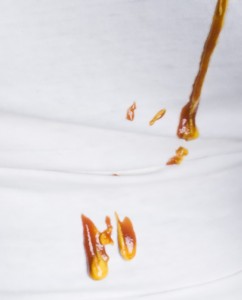Pretreatment Products
 Uh, oh. That hamburger was delicious, but you dripped some ketchup and mustard on your white shirt! Will just throwing it in the washer get the stain out? You can’t be sure, so it’s best to take action now so you can wear that white shirt again next Saturday.
Uh, oh. That hamburger was delicious, but you dripped some ketchup and mustard on your white shirt! Will just throwing it in the washer get the stain out? You can’t be sure, so it’s best to take action now so you can wear that white shirt again next Saturday.
Well, first, you need to get the culprits off your shirt: the ketchup and mustard. Rinse your shirt in cold water until all the excess food is gone. Be sure to rinse in cold water only, because warm water might help “set” the stain into the fibers of your shirt.
Ok, you’ve rinsed away much of the goo, but there are still a faint yellow and red stains clinging to the white fibers of your shirt. Now it’s time to turn to the stain-fighting power of laundry pre-treatments. They save the day when regular washing just isn’t enough.
There are four main ways stains are removed from fabric, and most commercial stain pre-treatment products utilize combinations of these methods:
1. The Stain Is Dissolved In A Solvent
A solvent is a liquid that dissolves a solid or another liquid. In the case of our ketchup-and-mustard stain, we are dealing with a semi-solid, semi-liquid solution. The rule is “like dissolves like.” Organic stains, like butter, bacon grease, or hamburger condiments, can be removed by organic solvents.
2. The Stain Is Removed And Lifted By A Surfactant
Surfactants work with solvents and water to remove, separate, and suspend the components of a stain. Surfactants essentially “make water wetter” which allows the product to penetrate the fabric fibers, surrounding the stain molecules, lifting them, and rinsing them away. Most laundry pre-treatments and stain removers contain surfactants.
3. The Stain Is Oxidized By A Bleach
Bleaches such as chlorines and peroxides de-colorize and/or break down the molecules in stains such as grass, wine and fruit juices. This makes them more water-soluble, and easier to wash away.
4. The Stain Is Digested By Enzymes
Enzymes are used to breakdown protein stains such as eggs, dairy products, meat, and juices, and starch stains such as pasta and baby food.
There are several methods of applying the pre-treatment. Stain removers come in spray bottles, squeeze bottles with bristles on the tip to help you rub out the stain, in solid sticks, wipes, and even in something that looks like a pen.
No mater how the pre-treatment attacks the stain, or how you apply it to the fabric, if it does its job, you’ll be able to save that shirt from winding up in the rag pile. You’ll also save time, energy, and water if you can wash that stain out on the first try. So next time you spill a little coffee or grape juice on your shirt, reach for the pre-treatment to blast out that stain!

